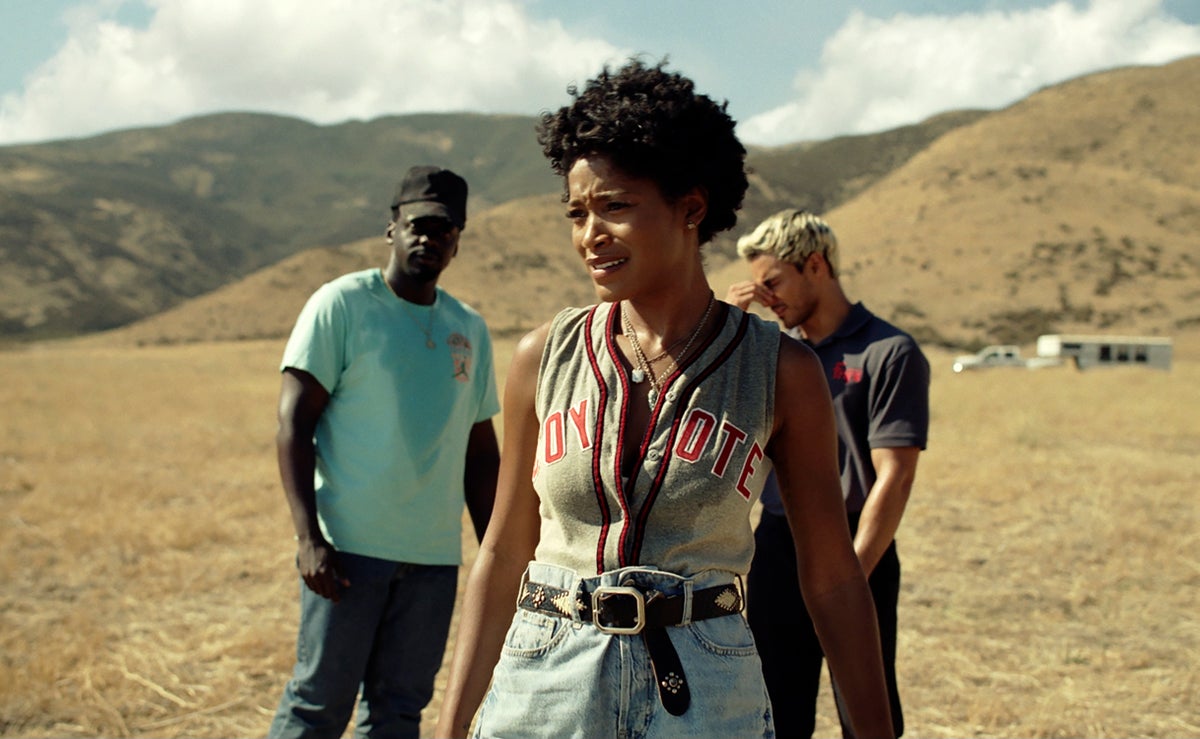
For his third film in the director’s chair, master moviemaker Jordan Peele has decided to go large. Gargantuan, in fact. A fantastical sci-fi that deals with UFOs, Hollywood heritage, and harrowing on-set sitcom murders, Nope was shot on IMAX cameras – every promotional poster for the film will proudly tell you so – which boost it from traditional blockbuster status to that of a sensational summer spectacle. With super high-res cameras and a flashy sound system at his disposal, the clever horror movie vision Peele set out on 2019’s Us and 2017’s Get Out is only getting grander.
We start by mooning over the stunning vistas of a fictional Californian desert town where siblings OJ (Daniel Kaluuya) and Emerald (Keke Palmer) now run the family horse ranch following the death of their father due to sinister shrapnel raining from the sky. When these suspicious goings on transpire to be due to malicious spacecraft, the film’s epic IMAX visuals truly come into their own. And it’s not just how things look – it’s how they sound. OJ and Emerald are intent on getting the camera shy UFO committed to film, but until they do we get an array of ultra creepy, super immersive noises – from whistling wind to whinnying horses – that drill their way into your head clearer and louder than your bog standard Dolby could ever manage.
I was lucky enough to see Nope at the IMAX in Hollywood’s legendary Chinese Theatre, and this is a film that deserves to be seen in a cinema just like it, on one of the format’s custom screens, otherwise the intended majesty of the movie risks being overlooked. Yet with just 11 proper IMAX screens in the UK and most US states with only a couple at most, not to mention significantly more expensive ticket costs, it’s likely that most viewers will just catch Nope down the local multiplex. Or, even worse, wait until it hits streaming services this autumn, then watch it in bed on a pokey 13-inch laptop screen.
In the mix with a bunch of now obsolete experimental film formats – so long Cinerama, farewell Smell-O-Vision, we hardly knew thee Interfilm – IMAX has been around since the early 1970s. For most of its life, however, it served a purpose that was as much about education as it was entertainment. Instead of screening the same movies as a regular cinema, IMAX made its name hosting showy documentaries shot to impress the viewer with their sheer scale, covering everything from Kuwaiti oil fires to tropical rainforests and roadster racing. The first film I ever saw on IMAX was 1991’s Antarctica, a 38-minute marvel about the continent’s spectacular topography. It was impressive, but I do remember thinking that it wasn’t nearly as good as The Little Mermaid.

It was only in 2002 that regular feature films began being converted into the format, and much later that they started being shot in IMAX, and even then only partially due to complications regarding the bulkiness of the cameras and the excess noise that early iterations created.
In 2018, with a new generation of cameras which circumnavigated such issues, the first full-length feature would be shot on IMAX. Since then, Top Gun: Maverick, Dune and now Nope have all dramatically used it to their advantage. Such is Peele’s obsession with the format that he’s currently working with the brand to develop new IMAX cameras alongside Christopher Nolan, who shot the forthcoming atomic bomb drama Oppenheimer on IMAX and calls it the “gold standard” of filmmaking.
“There’s a different kind of immersion that happens with IMAX and there’s a different kind of resolution,” Peele recently explained to Collider. “Once you direct in IMAX, there’s a real intoxication that happens. It’s hard. The possibilities open up so much when you see that format and you feel like, ‘Oh, wait a second. I can be somewhere in a more real sense.’ It’s pretty addictive.” All of this is certainly true, but if you’re not watching Nope on an IMAX screen, is it the case that a lot of Peele’s hard work that’ll simply get lost? Sadly, the answer might just be yep.







